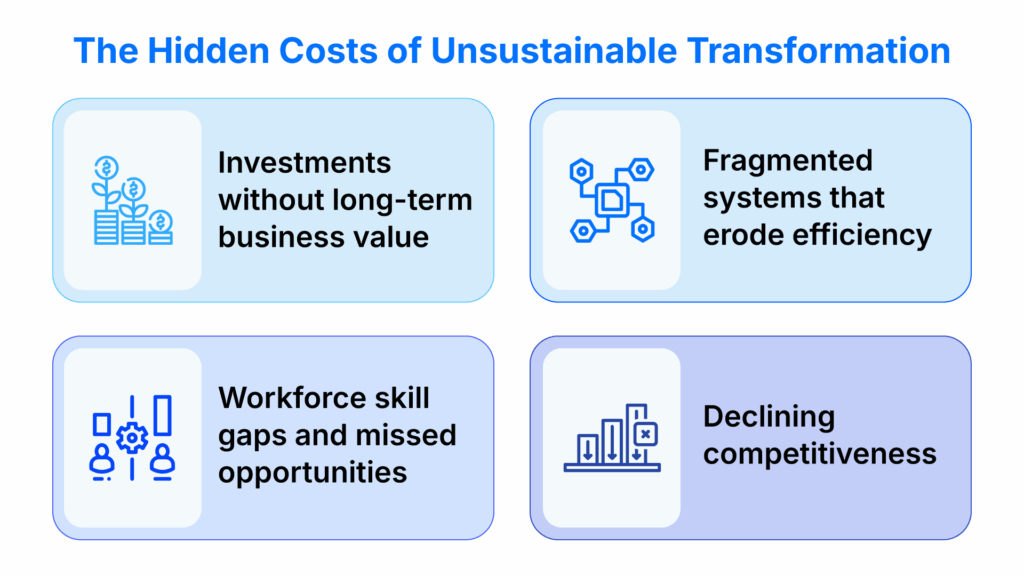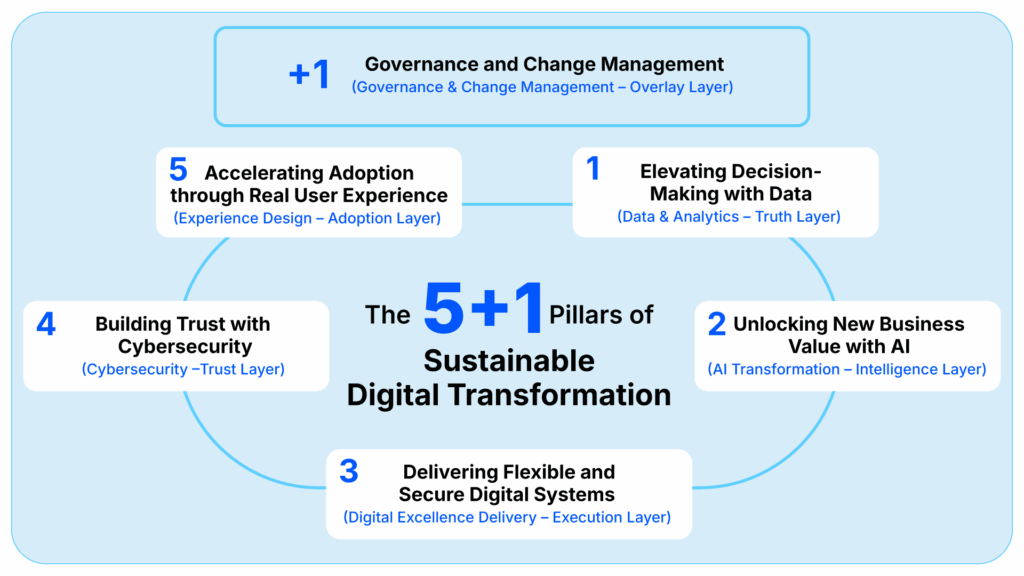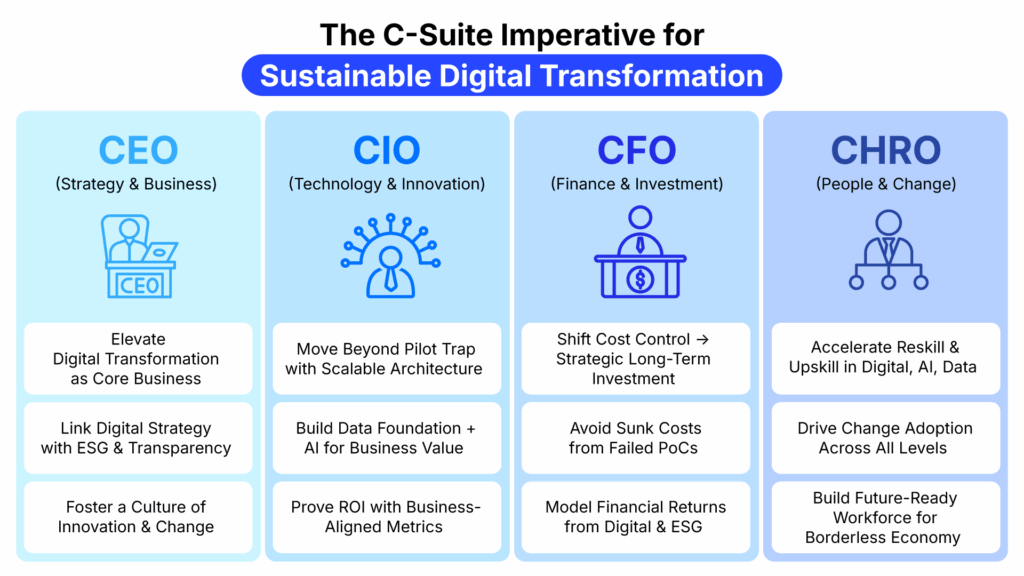Sustainable Digital Transformation: Redefining Business Advantage from Speed to Resilience
Unlocking transformation that scales, integrates, and builds enduring enterprise strength for the post-digital era.

In Brief
- Speed has defined digital initiatives in recent years — but without scalability and integration, speed alone delivers limited impact.
- As the post-digital era approaches, technology is shifting from differentiator to baseline expectation; CIOs will increasingly be measured on sustainability.
- Unsustainable transformation creates hidden costs: wasted PoCs, fragmented systems, workforce skill gaps, and lost competitiveness.
- Sustainable Digital Transformation, guided by Bluebik’s 5+1 model, reframes technology from a support tool into core infrastructure for long-term business value.
Over the past 2–3 years, companies worldwide have raced to launch digital initiatives, betting on Speed to Market as the path to competitive advantage. But speed, on its own, has proven fleeting. Without the ability to scale across the enterprise and integrate seamlessly with core operations and partner ecosystems, even the fastest moves fail to deliver lasting impact. As the world moves into the post-digital era, technology is shifting from a differentiator to a baseline expectation. The organizations that will thrive are those that go beyond speed—building connected systems, creating meaningful differentiation, and unlocking business value that endures. This marks the critical shift from speed to sustainability.
Global Signals: Why Sustainability Is Becoming the Next Measure of Success
After the speed-first wave, global analysts are pointing to sustainability as the defining benchmark for the next phase of transformation. Gartner projects that by 2027, 80% of CIOs will have performance metrics directly tied to the sustainability of their IT organizations. Similarly, IDC FutureScape 2025 forecasts that by 2026, half of IT leaders will rise to be recognized as business leaders—aligning people, operations, and business models with digital technologies.
These shifts signal that as the world moves into the post-digital era, organizations will require a resilient digital architecture — one capable of seamless integration, delivering superior user experiences, and scaling for the long term. In this context, technology must evolve from a “supporting tool” into the core infrastructure that drives enduring business advantage.
The Hidden Costs of Unsustainable Transformation

Without sustainability, transformation efforts risk becoming liabilities — generating hidden costs and risks that undermine long-term value across four critical areas:
1. Investments without long-term business value
- a. Wasted budgets from Proof of Concept (PoC) projects that struggle to scale into production.
- b. Over-investment in showcase projects with limited enterprise impact.
- c. Missed business opportunities due to IT infrastructure unable to scale effectively.
2. Fragmented systems (Digital Silos) that erode efficiency
- a. Data fragmentation leads to duplication and inconsistent outcomes.
- b. Resources and budgets consumed inefficiently.
- c. Inability to drive enterprise-wide productivity.
3. Workforce skill gaps and missed opportunities
- a. Employees have limited exposure to emerging skills in AI, holistic problem-solving, and data-driven decision-making.
- b. Widening skill gaps undermine future competitiveness.
- c. Higher costs for reskilling and recruiting talent.
4. Declining competitiveness
- a. Lagging in adapting to evolving regulations and ESG requirements.
- b. Market share loss due to slower customer response.
- c. Diminished influence within global industry ecosystems.
A New Agenda for Thai Enterprises
For Thai enterprises, aligning with global momentum will require more than technology adoption. It demands a strategic, sustainable approach to digital transformation — one that integrates Data, Artificial Intelligence, Cybersecurity, and Core Business Systems under strong governance and effective change management. The goal: to balance compliance, scalability, and long-term business value creation.

Local Examples of Transformation in Action
Early signs of this shift are already visible across Thai industries:
- Banking: Preparing for Virtual Banks with investments in AI-driven cybersecurity and data governance aligned with Bank of Thailand regulations.
- Healthcare: Hospitals and regional networks adopting ERP and data platforms to integrate patient information and comply with PDPA.
- Retail & Logistics: Leveraging AI and cloud-native applications to orchestrate omnichannel operations and optimize supply chains.
These cases illustrate that Thai enterprises are no longer at the starting point, but rather at the early stage of large-scale transformation. The challenge now is to move beyond adoption — embedding technology into strategy, workforce, and governance to deliver sustainable impact.
The 5+1 Pillars of Sustainable Digital Transformation
Sustainable transformation takes more than investment. It requires a structured framework that can scale impact, sustain momentum, and embed long-term value across the enterprise. Bluebik’s 5+1 model — built on 5 Core Pillars and 1 Overlay Layer — provides this framework: a practical guide to turning digital ambition into sustainable business outcomes.

1. Elevating Decision-Making with Data (Data & Analytics – Truth Layer)
- Insight: Many Thai organizations still struggle with fragmented reports and data silos, leading to delayed or distorted decision-making.
- Approach: Implement a Data Lakehouse combined with strong Data Governance to establish a Single Source of Truth — ensuring consistent, trusted data for real-time analytics.
- Value: Faster, more reliable decisions reduce opportunity loss, strengthen competitiveness, and provide the trusted foundation for AI-driven strategies.
2. Unlocking New Business Value with AI (AI Transformation – Intelligence Layer)
- Insight: A majority of AI projects in Thailand still struggle to move beyond the Proof of Concept (PoC) stage, limiting enterprise-wide impact.
- Approach: Embed AI across the value chain by combining Generative AI, Multi-Agent Systems, and MLOps with business-aligned use cases — ensuring sustainable model lifecycles.
- Value: Integrated AI reduces human error, enables enterprise-wide scalability, creates new S-Curves, and delivers measurable ROI.
3. Delivering Flexible and Secure Digital Systems (Digital Excellence Delivery – Execution Layer)
- Insight: Legacy technical debt continues to slow time-to-market, increase costs, and limit enterprise agility.
- Approach: Modernize with Microservices, API-First Architecture, DevSecOps, and Cloud-native practices to build agile, modular, and secure-by-design systems.
- Value: Delivers both speed and adaptability — enabling new business models and seamless technology adoption without costly rework.
4. Building Trust with Cybersecurity (Cybersecurity – Trust Layer)
- Insight: Cybersecurity has become a decisive factor for digital business resilience and continuity.
- Approach: Implement Zero Trust Architecture, AI-driven monitoring, and Data Loss Prevention (DLP), aligned with Thai regulations such as PDPA.
- Value: Robust security builds trust with customers, investors, and regulators — turning compliance into a competitive advantage.
5. Accelerating Adoption through Real User Experience (Experience Design – Adoption Layer)
- Insight: Digital transformation often falters due to low adoption, the most common barrier to transformation success.
- Approach: Apply human-centered design, user journey mapping, and usability testing, directly linked to business KPIs and change management.
- Value: Driving higher adoption and sustained change momentum ensures digital initiatives achieve their intended business outcomes.
+1. Governance and Change Management (Governance & Change Management – Overlay Layer)
- Insight: Many Thai organizations lack a dedicated Digital PMO, resulting in fragmented execution and stalled progress.
- Approach: Establish governance frameworks with ROI tracking, enterprise-wide accountability, structured change management, and continuous workforce reskilling.
- Value: The defining factor that separates one-off successes from sustainable transformation at scale.
The C-Suite Imperative for Sustainable Transformation
No single function can deliver sustainable transformation alone. Success depends on C-Suite alignment, where leaders across strategy, finance, technology, and people move in lockstep to steer the enterprise forward:

👩💼 CEO (Strategy & Business Direction)
- Reframe Digital Transformation from an “IT project” to a core business agenda.
- Link digital strategy with ESG and transparency priorities recognized by the Thai capital markets (SET).
- Shape a culture that embraces innovation and change.
👨💻 CIO (Technology & Innovation)
- Move beyond pilot projects by designing a digital architecture built for scale.
- Build strong data foundations and AI-driven capabilities to deliver real business value.
- Demonstrate ROI through metrics directly tied to business outcomes.
👨💼 CFO (Finance & Sustainable Investment)
- Shift from cost-control to strategic long-term investment.
- Prevent sunk costs from PoC projects that never scale.
- Develop financial models that capture digital and ESG returns while strengthening long-term resilience.
👩🎓 CHRO (People & Organizational Change)
- Accelerate reskilling and upskilling in digital, AI, and data.
- Design change adoption programs so employees grow alongside technology.
- Shape a future-ready people strategy to secure competitiveness in a borderless digital economy.
From Technology Investment to Future Advantage
True transformation goes beyond technology adoption. The real measure lies in how enterprises shape their future trajectory — embedding sustainability today to secure outcomes that extend beyond short-term wins and establish the foundation for long-term competitive advantage.
Bluebik partners with enterprises to drive Sustainable Digital Transformation — from strategy and architecture design to integrating technology and people. Our goal: to enable enduring, scalable business value.
Because the future of Digital Transformation will not be measured by speed alone, but by the sustainability that empowers organizations to advance with resilience and deliver lasting impact.
📩 Contact Bluebik today to begin your journey toward Sustainable Digital Transformation.
✉ [email protected] | ☎ 02-636-7011












